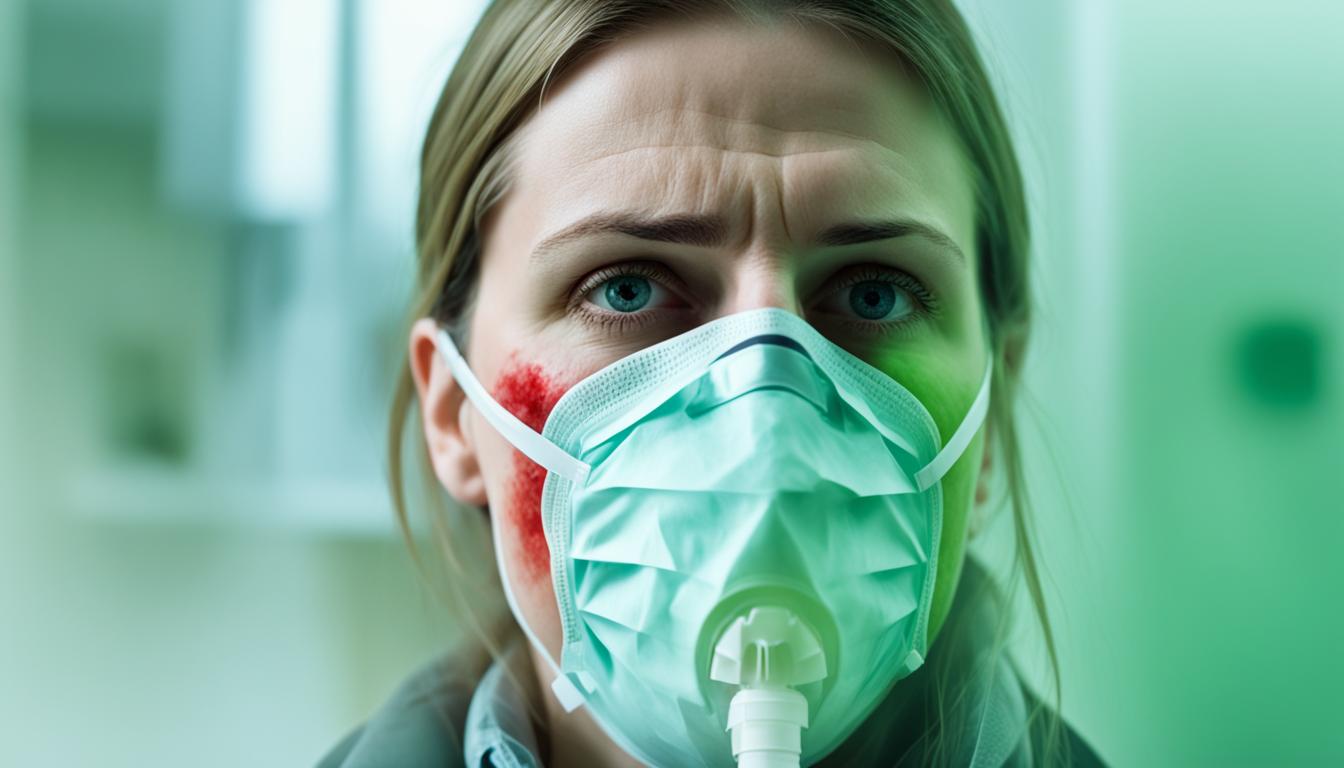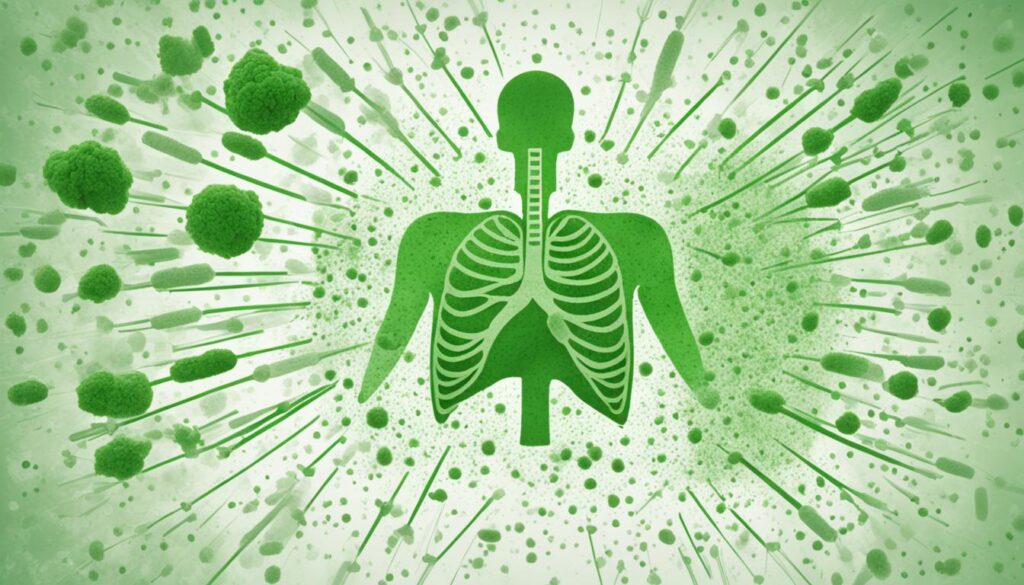
Health Alert: Symptoms of Breathing Mold Explained
Welcome to our informative article on the symptoms of breathing mold and the associated health risks. Mold exposure can have serious consequences for your health, and it is important to be aware of the signs that may indicate its presence.
Mold is a type of fungus that can grow in damp and humid conditions, such as in basements, bathrooms, or areas affected by water damage. When mold spores become airborne, they can easily be inhaled, potentially causing a range of health problems.
It is crucial to recognize the symptoms of breathing mold early on as they can vary depending on an individual’s sensitivity and the type of mold present. By understanding these symptoms, you can seek appropriate intervention and prevent further health complications.
Key Takeaways:
- Exposure to mold can lead to various health risks.
- Symptoms of breathing mold include respiratory problems, allergic reactions, and dermatological issues.
- It is important to seek professional help if you suspect mold in your indoor environment.
- Fix Mold Miami offers top-rated mold assessments, prevention, and remediation services in Florida. Call 305-465-6653 for a mold assessment.
- Early intervention is crucial to minimize the health effects of breathing mold.
Understanding Mold Exposure
Mold is a type of fungus that thrives in damp and humid conditions. It can be found both indoors and outdoors, and it has the potential to impact our health when we are exposed to it. Mold reproduces by releasing tiny spores into the air, which can easily be inhaled by humans and animals.
When mold spores become airborne, they can travel through the air and settle on various surfaces in our homes, such as walls, ceilings, and furniture. These spores are small enough to be invisible to the naked eye, but their presence can have significant effects on indoor air quality and our respiratory systems.
Exposure to mold spores can lead to a range of respiratory problems. Some individuals may experience allergic reactions, such as sneezing, coughing, and a runny or stuffy nose. Others may develop more severe symptoms, including wheezing, shortness of breath, and even asthma attacks. Prolonged exposure to mold can also contribute to the development of respiratory infections and other respiratory conditions.
In addition to respiratory problems, mold exposure has been linked to other health issues. Some people may develop skin rashes or irritation when they come into direct contact with mold. Others may experience allergic reactions on their skin, such as itching or hives.
“Exposure to mold spores can lead to a range of respiratory problems.”
It is important to understand that different individuals may react differently to mold exposure. While some people may experience mild symptoms, others may be more severely affected. Factors such as the type and amount of mold present, the duration of exposure, and individual susceptibility can all influence the health effects of mold exposure.
Impact of Mold on Indoor Air Quality

Mold growth can significantly impact the quality of indoor air. As mold spores are released into the air, they can circulate throughout a space and be inhaled by occupants. This can lead to poor indoor air quality, which has been linked to a variety of health problems, including respiratory issues, allergies, and even compromised immune systems.
In homes and buildings with high humidity levels or water damage, mold growth is a common concern. These conditions provide an ideal environment for mold to thrive and reproduce. It is essential to address any moisture issues promptly and take steps to prevent mold growth to maintain healthy indoor air quality.
By understanding the risks associated with mold exposure and taking preventive measures, we can protect our health and the quality of the air we breathe.
| Health Effects of Mold Exposure | Prevention Strategies |
|---|---|
| Respiratory problems Allergic reactions Skin irritation |
Maintain low humidity levels Fix water leaks promptly Improve ventilation Use mold-resistant materials |
Recognizing Symptoms of Breathing Mold
Breathing in mold can have detrimental effects on your health. It can trigger a variety of respiratory symptoms that should not be ignored. It is essential to recognize the signs early on to seek appropriate medical attention and take steps to eliminate mold in your environment.
Respiratory Symptoms:
- Coughing
- Wheezing
- Shortness of breath
These symptoms can range from mild to severe, depending on the individual’s sensitivity to mold and the extent of exposure. If you notice persistent or worsening respiratory issues, it is crucial to consult with a healthcare professional.
Allergic Reactions:
- Sneezing
- Runny nose
- Itchy eyes
Mold spores can trigger allergic reactions in susceptible individuals. These symptoms are similar to those experienced during seasonal allergies. If you notice these allergic reactions recurring or becoming more intense, it is advisable to address the potential presence of mold in your surroundings.
Dermatological Issues:
While respiratory symptoms and allergic reactions are commonly associated with mold exposure, some individuals may also experience dermatological issues:
- Skin rashes
- Skin irritation
These dermatological issues may occur when mold spores come into direct contact with the skin or when the skin is exposed to mold-contaminated surfaces or materials.
“Early recognition and action are key when it comes to symptoms of breathing mold. Seeking professional assistance for mold assessment and remediation is essential to protect your health and create a safe indoor environment.”
It is crucial to understand that these symptoms may vary depending on an individual’s sensitivity to mold, duration of exposure, and the type of mold present. Therefore, it is recommended to consult with healthcare professionals and mold remediation experts to address any concerns and ensure appropriate actions are taken to mitigate mold-related health risks.
Symptoms Respiratory Symptoms Allergic Reactions Dermatological Issues Coughing ✓ Wheezing ✓ Shortness of breath ✓ Sneezing Runny nose Itchy eyes Skin rashes Skin irritation
Conclusion
Mold exposure can have severe health consequences, making it crucial to recognize the symptoms of breathing mold for early intervention. If you suspect mold in your home or workplace, it is highly recommended to seek professional help.
One trusted expert in mold assessments, prevention, and remediation is Fix Mold Miami. As Florida’s highest-rated in mold assessments, prevention, and remediation specialist, they are dedicated to ensuring the safety of your indoor environment.
Contact Fix Mold Miami at 305-465-6653 to schedule a mold assessment and take the necessary steps to protect yourself and your loved ones from the potential health risks associated with mold exposure.





